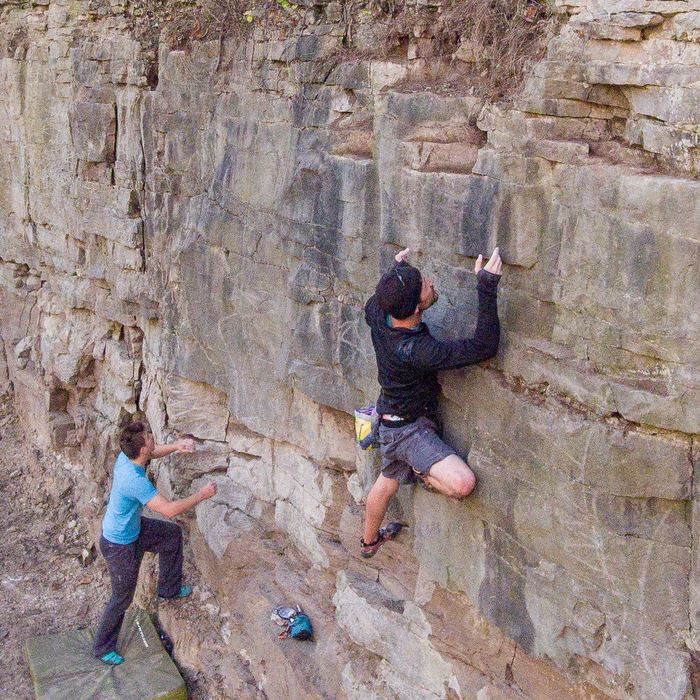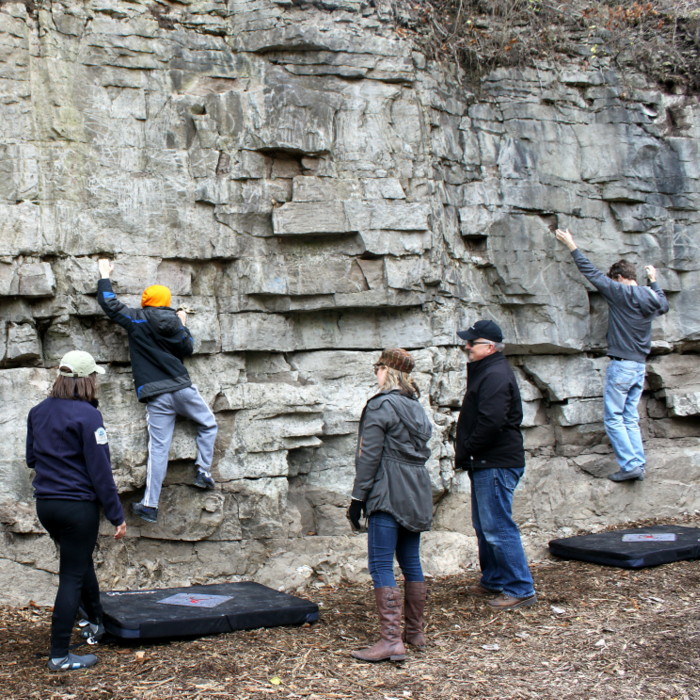Go Bouldering at Blue Creek!

Climbers of all ages have been enjoying a new limestone bouldering wall recently opened at the Nona France area of Blue Creek Metropark. From young children just learning to experienced climbers, this wall offers something for everyone with a taste for adventure.
Limestone, a type of chemical sedimentary rock, forms underwater in warm, clear, shallow oceans from the broken and compacted shells and skeletons of once-living marine (ocean dwelling) organisms like corals, snails, and brachiopods. Limestone does not erode easily—thus providing a solid surface for climbing. You can expect vertical to overhanging cliffs and caves from limestone, making it an ideal rock for sport climbing. Some of the best climbing destinations, both in the US and internationally, are limestone climbing areas.
Bouldering Basics
Bouldering is rock climbing in its simplest form, without the ropes, harnesses and other hardware required for safety at taller rock faces. It’s easy to see why so many people are drawn to this type of climbing, as it’s an affordable and fun social activity. You don’t need a lot of fancy gear, knowledge, or experience to get started, making it perfect for the beginner climber. The new bouldering wall also offers enough challenge for experienced climbers to continue practicing and refining their craft, making it a great location for climbers of all experience levels.
To start bouldering, find yourself a buddy or two, wear comfortable athletic clothing that will allow you to stretch and move, and grab your crash pad and rock climbing shoes (or other closed-toed athletic shoes) to hit the wall. Hand chalk and finger tape are optional extra gear that may make your climbing experience more enjoyable.
Reaching the bouldering wall is easy; it’s located off a short gravel path a very short walk from the parking lot near the Nona France sledding hill. The entrance is on Providence Street, near the Whitehouse Village offices. Grab your friends or family and make a fun day out of challenging each other to try the same climbing route, or see who can make it the furthest horizontal distance without falling.
Before starting it’s always a good idea to stretch and warm up. Keep your body close to the wall without hugging the wall, and use your legs for climbing and supporting your body weight, and your arms for balance.

Bouldering Safety and Injury Prevention
In bouldering, falling off the rock is a constant occurrence. Rather than using a rope for protection, use partners, padding and your common sense.
Remember that you don’t have ropes and harnesses to protect you from a fall, so be smart about how high you climb. The goal should be to move horizontally along the cliff face without touching the ground, not to climb vertically up the cliff face.
For your safety you should never climb higher than you are tall, meaning that your feet should never be higher on the cliff face than your head would be if you were standing on the ground.
Crash pads: These thick mats are used to cushion your fall. They must be brought to the bouldering wall and strategically placed in your fall zone. More than one pad may be needed to ensure complete coverage along the base of the wall. If you have only one crash pad your spotter can drag or kick it along the base of the rock wall below you as you move.
Spotters: Rather than trying to catch you, the job of a spotter is to ensure that your head and shoulders don't hit the ground. Having more spotters is always better. Spotters should stand back from the rock wall several feet, off the crash pad, and follow the climber as they move horizontally along the wall.
Keep in mind that climbing is an inherently dangerous sport. Participate in bouldering at your own risk.
It’s helpful to first read up on the sport. We found this helpful advice on REI.com.